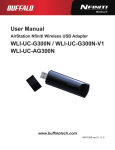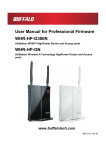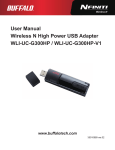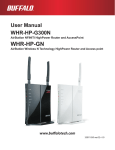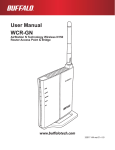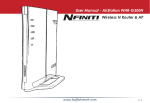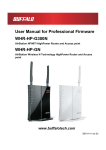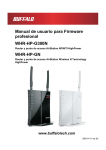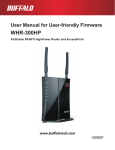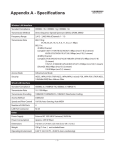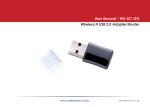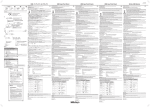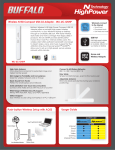Download Buffalo Tech WLI-UC-GN User manual
Transcript
User Manual Wireless N High Power USB 2.0 Adapter WLI-UC-GNHP www.buffalotech.com 35010984 ver.02 Contents Chapter 1 Product Overview............................................ 4 Features................................................................................... 4 150 Mbps High Speed Mode.................................................... 4 System Requirements.............................................................. 5 Package Contents.................................................................... 5 Hardware Overview.................................................................. 5 Chapter 2 Installation........................................................6 Installing Wireless Drivers........................................................ 6 Installing Client Manager Utility................................................ 10 Chapter 3 Connect to a Wireless Network...................... 13 Automatic Secure Setup (AOSS/WPS).................................... 13 Windows Vista (Client Manager V)................................................. 14 Windows XP (Client Manager 3)..................................................... 15 Automatic Secure Setup (WPS PIN)........................................ 16 Windows Vista (Client Manager V)................................................. 16 Windows XP (Client Manager 3)..................................................... 20 Manual Setup (Client Manager)............................................... 22 Windows Vista (Client Manager V)................................................. 22 Windows XP (Client Manager 3)..................................................... 25 Manual Setup (Windows Utility)............................................... 26 Windows Vista (WLAN AutoConfig)................................................ 26 Windows XP (Wireless Zero Configuration).................................... 29 WLI-UC-GNHP User Manual 1 Chapter 4 Client Manager................................................. 30 Software Overview................................................................... 30 Using Client Manager V with Windows Vista........................... 30 Opening and Closing Client Manager............................................. 30 Main Screen.................................................................................... 31 Automatic Secure Setup and Advanced Setup............................... 32 SSID / WPS-PIN selection.............................................................. 33 Searching Wireless Access Points.................................................. 34 Wireless Network Information......................................................... 35 WPS-PBC / AOSS selection........................................................... 36 Wireless Status............................................................................... 37 Wireless LAN Diagnostics............................................................... 39 Profile List....................................................................................... 40 Extended Properties (Wireless)...................................................... 41 Extended Properties (Network)....................................................... 42 Extended Properties (Browser)....................................................... 43 Extended Properties (Printers)........................................................ 44 Using Client Manager 3 with Windows XP............................... 45 Opening and Closing Client Manager............................................. 45 Status.............................................................................................. 46 Scan................................................................................................ 48 Connect........................................................................................... 49 Profiles............................................................................................ 50 Profile Information (Basic)............................................................... 51 Profile Information (Network).......................................................... 53 Profile Information (Browser).......................................................... 54 Profile Information (Printers)........................................................... 55 System Tray Menu.......................................................................... 56 Option Menu................................................................................... 57 WLI-UC-GNHP User Manual 2 Chapter 5 Trouble Shooting............................................. 59 The Computer does not recognize the WLI-UC-GNHP Wireless Adapter..................................................................................... 59 Cannot connect to the network wirelessly................................ 59 You forgot SSID, Encryption KEY, or Password....................... 59 Other Tips................................................................................. 60 Appendix . .................................................................... 63 150 Mbps Mode settings.......................................................... 63 Specifications........................................................................... 64 Removing the device from the computer................................. 65 Uninstalling the Software......................................................... 65 Uninstalling the Drivers............................................................ 65 TCP/IP Settings........................................................................ 66 Antenna.................................................................................... 67 Compliance Information........................................................... 68 Environmental Information....................................................... 75 Warranty Information................................................................ 76 Contact Information (USA / Canada)........................................ 77 Contact Information (Europe)................................................... 78 WLI-UC-GNHP User Manual 3 Chapter 1 Product Overview Features This product supports 2.4 GHz SISO-OFDM/OFDM and 2.4 GHz DS-SS transfer methods and works with IEEE 802.11n and IEEE 802.11b/g wireless devices. Data transmission rates of up to 150 Mbps are available. It also includes support for AOSS (AirStation One-touch Secure System) and WPS (Wi-Fi Protected Setup), making connection with wireless devices easier. The AirStation supports the following wireless encryption modes: • WPA-PSK (TKIP/AES) • WPA2-PSK (TKIP/AES) • WEP (128/64bit) The movable antenna is adjustable for best performance. 150 Mbps High Speed Mode 150 Mbps is the link speed when using Wireless-N mode. It represents actual wireless data speeds, including overhead. Because the overhead is not available for user data transfer, usable wireless throughput will be substantially slower. WLI-UC-GNHP User Manual 4 Chapter 1 Product Overview System Requirements This product is designed for use with PCs running the 32 bit versions of Windows Vista or Windows XP. A USB 2.0 port is required. Either a CD-ROM drive or an internet connection is recommended. This product does not support computers equipped with dual processors (computers with 2 physical CPUs). Computers with dual core CPUs are supported. Compatible operating systems: Windows Vista (32bit)* Windows XP (32 bit) (with Service Pack 2 or later)* *Standby mode is not supported. Package Contents The following items are included in your package. If any of the items are missing, please contact your vender. • WLI-UC-GNHP................................................................................................................................ 1 • USB connector (option).............................................................................................................. 1 • Air Navigator CD............................................................................................................................ 1 • Quick Setup Guide....................................................................................................................... 1 Hardware Overview ACT LED (Blue) Flashes when sending or receiving data. WLI-UC-GNHP User Manual Movable Antenna Point straight up for best performance. 5 Chapter 2 Installation Installing Wireless Drivers Follow the instruction below to install drivers. Do not connect the AirStation to your computer yet. 1 Boot your computer and insert the AirNavigator CD. The AirNavigator Setup Wizard will launch automatically. Note: If the AirNavigator Setup Wizard doesn’t open, double click "My Computer", then your CD-ROM drive, then ”AirNavi.exe”. 2 Click “Begin Installation”. 3 Click “AirStation Wireless LAN Adapters”. WLI-UC-GNHP User Manual 6 Chapter 2 Installation 4 Disable the firewall if it is enabled, and click “Next”. 5 Click “Install”. Note: 6 WLI-UC-GNHP User Manual If you check the box to Install Wireless Client Manager, Client Manager software will also be installed. You may install Client Manager software later if desired. Click “Next”. 7 Chapter 2 Installation 7 Read the license agreement and select “Agree”. Then click “Next”. 8 Check Always trust software from "BUFFALO INC." and click “Install”. 9 When this screen is displayed, attach the AirStation to your computer. Drivers will be automatically installed. WLI-UC-GNHP User Manual 8 Chapter 2 Installation 10 Click “OK”. 11 Click “Finish”. Note: If you checked “Install Wireless Client Manager”, the Client Manager installation wizard will run after this screen. Follow the instructions on the screen to install Client Manager. You have installed drivers for your wireless AirStation client. WLI-UC-GNHP User Manual 9 Chapter 2 Installation Installing Client Manager Utility If you didn’t install the “Client Manager” software with the drivers, you can install it later. 1 Boot your computer and insert the AirNavigator CD. The AirNavigator Setup Wizard will launch automatically. Note: If the AirNavigator Setup Wizard doesn’t open, double click “My Computer”, then your CD-ROM drive, then ”AirNavi.exe”. 2 Click “Options”. 3 Click “Advanced Installation”. WLI-UC-GNHP User Manual 10 Chapter 2 Installation 4 Check the box for “Install Wireless Client Manager”, then click “Install”. Note: Select Client Manager V for Windows Vista or Client Manager 3 for Windows XP. 5 Click “Next”. 6 Read the license agreement and select “Agree”. WLI-UC-GNHP User Manual 11 Chapter 2 Installation 7 Click “Next”. 8 Click “OK”. 9 Click “Back”. 10 Click “X” at the top right corner of the window to close it. Client Manager installation is complete. WLI-UC-GNHP User Manual 12 Chapter 3 Connect to a Wireless Network Automatic Secure Setup (AOSS/WPS) AOSS and WPS are systems which automatically configure wireless LAN settings. Just pressing the buttons will connect wireless devices and complete security settings. Utilize this system to connect to wireless devices, computers, or game machines which support AOSS or WPS. AOSS was developed by Buffalo Technology. WPS was created by the Wi-Fi Alliance. Internet őŖŔʼn őŖŔʼn ÅÒ ÐÏ× ÓÅà ÕÒÉ ÔÙ ÅÓÓ ÒÅÌ ×ÅÉ ÔÅÒ ÒÏÕ Ç ÄÉÁ Modem AirStation PC or Game console (AOSS Devices) Install Client Manager from the AirNavigator CD before using AOSS or WPS. WLI-UC-GNHP User Manual 13 Chapter 3 Connect to a Wireless Network Windows Vista (Client Manager V) If you are using Windows Vista, use the Client Manager V software to connect wirelessly with AOSS or WPS. 1 Click the icon in the system tray to open Client Manager. 2 Click “Create Profile”. WLI-UC-GNHP 3 When the message “A Program needs your permission to continue” appears, click “Continue”. 4 WLI-UC-GNHP User Manual Click the “WPS AOSS “ button. 14 Chapter 3 Connect to a Wireless Network When AOSS/WPS is complete, the Security LED will stop flashing and remain lit. The message "Connection has been Completed" is displayed in Client Manager. If the “Set Network Location” screen opens, select “Home”, “Work”, or “Public location” depending on where the AirStation will be used. Windows XP (Client Manager 3) If you are using Windows XP, use the included Client Manager 3 software to connect wirelessly with AOSS or WPS. 1 Right click on the icon in the system tray and select “Profile”. 2 When the screen shown at left is displayed, click “WPS AOSS” button. When AOSS/WPS is complete, the Security LED will stop flashing and remain lit. The message "Security setup and connection have been Completed" is displayed in Client Manager. WLI-UC-GNHP User Manual 15 Chapter 3 Connect to a Wireless Network Automatic Secure Setup (WPS PIN) The WPS standard also supports the use of a PIN (Personal Identification Number) to connect a wireless client to a network. Use this feature if your wireless router supports WPS PIN. Note: Install Client Manager software from the AirNavigator CD before using WPS PIN. Windows Vista (Client Manager V) If you are using Windows Vista, use Client Manager V to connect wirelessly with a WPS PIN. 1 Click the icon in the system tray. 2 Click “Create Profile”. WLI-UC-GNHP 3 When the message "A Program needs your permission to continue" appears, click “Continue”. WLI-UC-GNHP User Manual 16 Chapter 3 Connect to a Wireless Network 4 Click the “Advanced Setup “ button. 5 Click the “WPS-PIN” button. WLI-UC-GNHP User Manual 17 Chapter 3 Connect to a Wireless Network 6 This is the PIN code; write it down. Then click “Next”. 7 Select the access point you are going to connect to and click “Next”. This screen will be displayed. WLI-UC-GNHP User Manual 18 Chapter 3 Connect to a Wireless Network 8 Connect your computer to the wireless router with a wired Ethernet cable. Log in to the wireless router’s configuration utility and navigate to its WPS page. If your router is a Buffalo AirStation, then the WPS page will be under the Wireless Config tab. 9 Enter the PIN code you wrote down in step 6. Example: If the access point you are trying to connect is a Buffalo AirStation, enter the PIN code in “Enrollee PIN” and click “OK”. If the “Set Network Location” screen is displayed, select “Home”, “Work”, or “Public location” depending on where the AirStation will be used. When the message "Connection has been Completed” is displayed in Client Manager V, you may disconnect the Ethernet cable. Your computer is now connected to the network wirelessly. WLI-UC-GNHP User Manual 19 Chapter 3 Connect to a Wireless Network Windows XP (Client Manager 3) If you are using Windows XP, use Client Manager 3 to connect wirelessly with a WPS PIN. 1 Right click on the PIN Code type”. icon displayed in the system tray, and select “Easy Connection” > “WPS 2 Write down the PIN code and click “Next”. 3 Select the access point you are going to connect to and click “Next”. WLI-UC-GNHP User Manual 20 Chapter 3 Connect to a Wireless Network This screen will be displayed. 4 Connect your computer to the wireless router with a wired Ethernet cable. Log in to the wireless router’s configuration utility and navigate to its WPS page. If your router is a Buffalo AirStation, then the WPS page will be under the Wireless Config tab. 5 Enter the PIN code you wrote down in step 6. Example: If the access point you are trying to connect is a Buffalo AirStation, enter the PIN code in “Enrollee PIN” and click “OK”. When the message "Connection has been Completed” is displayed in Client Manager 3, you may disconnect the Ethernet cable. Your computer is now connected to the network wirelessly. WLI-UC-GNHP User Manual 21 Chapter 3 Connect to a Wireless Network Manual Setup (Client Manager) If your access point doesn’t support AOSS or WPS, you may configure your connection manually. The procedure is slightly different if you have Windows XP or Vista. These directions assume that you have already installed Client Manager software (page 10). Windows Vista (Client Manager V) With Windows Vista, use Client Manager V to connect wirelessly. 1 Click the icon in the system tray. 2 Click “Create Profile “. WLI-UC-GNHP 3 When the message "A Program needs your permission to continue" appears, click “Continue”. WLI-UC-GNHP User Manual 22 Chapter 3 Connect to a Wireless Network 4 Click the “Advanced Setup“ button. 5 Click the “Connect Manually” button. WLI-UC-GNHP User Manual 23 Chapter 3 Connect to a Wireless Network 6 Select the access point to connect to and click “Next”. 7 Choose “Network Type”, “Network Name” (SSID), and “Security Type”. Enter an “Encryption Key” (pass phrase) and click “Connect.” If the “Set Network Location” screen is displayed, select “Home”, “Work”, or “Public location” depending on where the AirStation will be used. When the message "Connection Complete” is displayed in Client Manager V, your computer is connected to the network wirelessly. WLI-UC-GNHP User Manual 24 Chapter 3 Connect to a Wireless Network Windows XP (Client Manager 3) With Windows XP, use Client Manager 3 to connect wirelessly. 1 Right click on the icon in the system tray and select “Scan”. 2 Select the access point to connect to and click “Connect”. 3 Choose the type of encryption used by your network and enter one of more encryption keys. Click “Connect” to connect to the network. WLI-UC-GNHP User Manual 25 Chapter 3 Connect to a Wireless Network Manual Setup (Windows Utility) You can also connect to an access point without installing Client Manager V or Client Manager 3 by using the wireless utility built-in to Windows. The procedure varies depending on the version of Windows used. Windows Vista (WLAN AutoConfig) Use Windows standard utility (WLAN AutoConfig) to connect to your access point. 1 Right click on the wireless network icon 2 Click “Connect to a network”. 3 WLI-UC-GNHP User Manual in the system tray. Select your wireless network to connect to and click “Connect”. 26 Chapter 3 Connect to a Wireless Network If the screen below is displayed, click “I want to enter the network key or pass phrase instead”. WLI-UC-GNHP User Manual 27 Chapter 3 Connect to a Wireless Network 4 Enter the encryption key (passphrase) and click “Connect”. If the “Set Network Location” screen is displayed, select “Home”, “Work”, or “Public location” depending on where the AirStation will be used. WLI-UC-GNHP User Manual 28 Chapter 3 Connect to a Wireless Network Windows XP (Wireless Zero Configuration) Windows XP includes a built-in utility to connect to your access point. Note: If Client Manager 3 is installed on your computer, Wireless Zero Configuration is disabled. Uninstall Client Manager 3 to use Wireless Zero Configuration, or just use Client Manager 3 to connect to the AirStation. 1 Right click on the wireless network icon 2 Click “View Available Wireless Networks”. in the system tray. 3 Select the network to connect to and click “Connect”. 4 When the screen at left is displayed, enter the encryption key (passphrase) and click “Connect”. You are now connected to the wireless network. WLI-UC-GNHP User Manual 29 Chapter 4 Client Manager Software Overview Client Manager is software to manage your wireless connection. See page 10 to install Client Manager on your computer. Note: There are two versions of Client Manager with this unit, "V" and "3". Client Manager V supports Windows Vista. Client Manager 3 supports Windows XP. Using Client Manager V with Windows Vista Opening and Closing Client Manager • After installation, Client Manager automatically launches when Windows boots. To load Client Manager manually, click “Start“ > “All Programs” > “BUFFALO” > “AirStation Utility” > “ClientManagerV” . • Right click on the Client Manager icon in the system tray and click “Exit” to close Client Manager. The appearance of the Client Manager icon in the systray will change according to its connection status: : Not connected : Communicating via an access point WLI-UC-GNHP User Manual 30 Chapter 4 Client Manager Main Screen The Main screen displays the current connection status. You can perform the following operations from this screen. WLI-UC-GNHP 150 Mbps Parameter Meaning Profiles Displays information about currently available wireless connections. If you have multiple connection points, you can switch among them. Transmission Speed Displays the current connection speed. Signal Strength Displays the signal strength of the current connection. Create Profile Click this to display the Automatic Secure Setup and Advanced Setup screen. Advanced Click this to display the Wireless Status screen. WLI-UC-GNHP User Manual 31 Chapter 4 Client Manager Automatic Secure Setup and Advanced Setup Use this screen to connect to an access point automatically with AOSS or WPS. You can also connect manually from here. Parameter Meaning Wireless Adapter Displays names of currently used wireless devices. Automatic Secure Setup Clicking this will start configuring the security settings automatically for an access point which supports AOSS or WPS. You can easily setup the wireless connection and security settings by just following instructions on the screen. Advanced Setup Configure the settings for an access point manually. Click this to display the SSID/WPS-PIN selection screen. Option (Expert only) Click this to specify whether you use AOSS or WPS for connection in Automatic Secure Setup. It displays the WPS/AOSS selection screen. WLI-UC-GNHP User Manual 32 Chapter 4 Client Manager SSID / WPS-PIN selection If you your access point supports WPS-PIN, you can connect to it from here. This page also allows you to enter an SSID manually. Parameter Meaning Connect Manually Specify SSID of an access point and configure connection settings. Click here to display the Searching Wireless Access Points screen. Connect with WPS-PIN Click this to connect to a WPS compatible access point using a PIN. WLI-UC-GNHP User Manual 33 Chapter 4 Client Manager Searching Wireless Access Points This screen lists available wireless access points. You can select an access point and connect to it. Parameter Meaning Network Name (SSID) Displays the SSID of each available access point. Security Lock icon appears if the network has security enabled. Channel Displays the wireless channel of each available access point. Strength Displays the signal strength for each available access point. Enter the Network Name (SSID) manually Click this to entering an SSID manually. This displays the Wireless Network Information screen. Search Click here to search an access point again. Next Click this to display the Wireless Network Information screen. WLI-UC-GNHP User Manual 34 Chapter 4 Client Manager Wireless Network Information This screen lets you manually enter access point information. Parameter Meaning Network Type Select transmission method. Network Name (SSID) Enter an SSID of an access point. Security Type Select the security type. Encryption Method Select the encryption method. Encryption Key or Passphrase Enter an encryption key (pass phrase). Connect to a network which does not Check to connect to a wireless network that doesn’t broadcast its broadcast the SSID SSID. Connect WLI-UC-GNHP User Manual Click to connect. 35 Chapter 4 Client Manager WPS-PBC / AOSS selection Push-button connection to an access point that supports WPS or AOSS. Parameter Meaning Automatic Secure Setup WPS-PBC method Click this to connect to a WPS compatible access point, then push the WPS button on the access point or in its software. You will be connected to the network automatically. Automatic Secure Setup AOSS method Click this to connect to an AOSS compatible access point, then push the AOSS button on the access point or in its software. You will be connected to the network automatically. WLI-UC-GNHP User Manual 36 Chapter 4 Client Manager Wireless Status The Status screen displays the current connection status. WLI-UC-GNHP ed Parameter Meaning Adapter Displays the name of the wireless device (this unit) which is currently used. Execute wireless LAN diagnostics Displays the Wireless LAN Diagnostic screen. Profile Name Displays the current profile name. Status Displays the current transmission status. Network Mode Displays the current network mode. Transmission Speed Displays the current transmission speed. SSID Displays the SSID of the currently connected access point. Channel Displays the current wireless channel. WLI-UC-GNHP User Manual 37 Chapter 4 Client Manager Parameter Meaning Security Displays whether or not the wireless connection is encrypted. Authentication Type Displays the type of authentication currently used. Encryption Type Displays the type of encryption currently used. Signal Strength Displays the current signal strength. IP Address Displays the IP address assigned to this unit. Subnet Mask Displays the subnet mask assigned to this unit. Default Gateway Displays the default gateway destination address. Primary DNS Displays the primary DNS address of your connection destination. Secondary DNS Displays the secondary DNS address of your connection destination. MAC Address Displays your wireless device’s MAC address. WLI-UC-GNHP User Manual 38 Chapter 4 Client Manager Wireless LAN Diagnostics On this screen you can check signal strength and quality. WLI-UC-GNHP Parameter Meaning Adapter Displays the name of the wireless device (this unit) currently in use. Connection status Displays signal strength (dBm), link rate (Mbps) and signal quality (%) in chronological order in 1 minute intervals. Note the following: • Some wireless devices may not be displayed. • Signal strength and quality may vary among different devices. So, comparisons between readings for different wireless clients may not be valid. Use these reading to compare wireless status with the same wireless device. Usage of each channel This utility displays information for 2.4 GHz 11b/11g networks. 5 GHz 11a networks are not supported. The color expresses a network’s signal strength. Stronger signals are more red; weaker signals are more blue. WLI-UC-GNHP User Manual 39 Chapter 4 Client Manager Profile List Create or edit profiles from this page. WLI-UC-GNHP Parameter Meaning Adapter Displays the name of the current wireless client (such as the WLIUC-GNHP AirStation) in use on your computer. New Click to create a new profile. Edit Edit the selected profile. Click this to display the Extended Properties screens. Delete Delete the selected profile. Down Lower the priority of the selected profile. Up Raise the priority of the selected profile. WLI-UC-GNHP User Manual 40 Chapter 4 Client Manager Extended Properties (Wireless) View the wireless settings for a profile. Parameter Meaning Connection Displays the current profile name. SSID Displays the SSID of the currently connected access point. Security Type Displays the current connection’s security type. Encryption Type Displays the current connection’s encryption type. Security key or Pass phrase Displays the security key or pass phrase if “Display password visible“ is checked. Connect an access point even SSID broadcasting is disabled. Check to connect to a wireless network that doesn’t broadcast its SSID. WLI-UC-GNHP User Manual 41 Chapter 4 Client Manager Extended Properties (Network) You may configure Client Manager to use different network settings when connected wirelessly with this profile. Parameter Meaning Do not change IP Address settings of this Profile Keeps current TCP/IP network settings. Use the following settings Select this option to configure different TCP/IP network settings when connecting wirelessly with this profile. You can configure IP address, Subnet Mask, Default gateway, and DNS server address settings. WLI-UC-GNHP User Manual 42 Chapter 4 Client Manager Extended Properties (Browser) You may configure Client Manager to use different browser settings when connected wirelessly with this profile. Parameter Meaning Do not change the browser settings of this Profile Keeps current Internet Explorer settings. Use the following settings Select this option to configure different settings for Internet Explorer home page and proxy server when connecting wirelessly with this profile.. WLI-UC-GNHP User Manual 43 Chapter 4 Client Manager Extended Properties (Printers) You may configure Client Manager to use different printer settings when connected wirelessly with this profile. Parameter Meaning Do not change the printer settings of Keeps current printer settings. this Profile Use the following settings WLI-UC-GNHP User Manual Select this option to use a different printer when connecting wirelessly with this profile. 44 Chapter 4 Client Manager Using Client Manager 3 with Windows XP Opening and Closing Client Manager • After installation, Client Manager automatically launches when Windows boots. To launch Client Manager manually, click “Start” > “All Programs” > “BUFFALO” > “AirStation Utility” > “ClientManager3” . • Right click on the Client Manager icon in the system tray and click “Exit” to close Client Manager. The appearance of the Client Manager icon in the systray will change according to its connection status: : Wireless client is not connected to the computer : No connection to access point : Transmitting via an access point (encrypted with TKIP/AES) : Transmitting via an access point (Encrypted with WEP, or not encrypted) : Transmitting in ad-hoc mode (not supported with this unit) : Authenticating WLI-UC-GNHP User Manual 45 Chapter 4 Client Manager Status The Status screen displays the current connection status. WLI-UC-GNHP 150Mbps Parameter Meaning Profile Displays the name of the profile currently in use. SSID Displays the currently connected access point’s SSID. Adapter Name Displays the name of the current wireless client. Network Type Displays the current network mode. Transmission Speed Displays the current transmission speed. Channel Displays the current wireless channel. Security Displays whether this connection uses encryption. IP Address Displays the IP address assigned to this unit. WLI-UC-GNHP User Manual 46 Chapter 4 Client Manager Parameter Meaning MAC Address Displays the MAC address of this unit. Duration Displays the duration of this connection. Signal Strength Displays the current signal strength. Reconnect Click this to reconnect with this profile. WLI-UC-GNHP User Manual 47 Chapter 4 Client Manager Scan This screen lists available wireless access points. You can select an access point and connect to it. Parameter Meaning SSID Lists SSIDs of each available access point. Wireless mode Displays the type of wireless network (11a or 11g) for each access point. Channel Displays the wireless channel used by each access point. Strength Displays the signal strength of each access point. Encryption Lock icon appears if the access point has encryption enabled. Connect Click to navigate to the Connect screen.. Refresh Click to relist available access points. WLI-UC-GNHP User Manual 48 Chapter 4 Client Manager Connect This screen configures settings to connect to an access point. Parameter Meaning Encryption Method Select the encryption type used by the access point. Encryption Key Enter at least one encryption key (pass phrase) for the access point. Register Profile Check to save these settings as a profile. WLI-UC-GNHP User Manual 49 Chapter 4 Client Manager Profiles View or edit profiles here. Parameter Meaning Connect Select a profile, then click this button to connect. Add Click to add a new profile. Displays the Profiles Information screen. Edit Click to edit or delete a profile. WPS AOSS Click to have connect automatically with AOSS or WPS. After connection, a profile for this connection is created automatically. 802.1x Profiles This button is displayed when Client Manager is operating in Business Mode. Click to configure 802.1x authentication. WLI-UC-GNHP User Manual 50 Chapter 4 Client Manager Profile Information (Basic) Configure basic settings for a profile. Parameter Meaning Display Icon Choose a display icon for this profile from the dropdown list. Select Profile Profile may be configured to use either a wireless or wired connection. For use with the AirStation wireless client, choose wireless. Profile Name Choose a name for this profile. Network Type For use with an access point, choose “Infrastructure Mode”. To connect to another wireless client, chose “Ad-hoc Mode”. SSID The SSID is the “name” of the network that you’re connecting to.. Channel Auto-Channel will select the best channel for you automatically, or you may choose a specific channel manually. In Infrastructure mode, Auto-Channel is enabled. Encryption Method Select the encryption method used by this access point. WLI-UC-GNHP User Manual 51 Chapter 4 Client Manager Parameter Meaning Transmission Key Enter the number of encryption keys allowed. If using WEP for Encryption, you may enter up to four encryption keys. Only a single key is necessary. Encryption Key Enter an encryption key or keys. AP is set to exclusive connection Check to connect to a wireless network that doesn’t broadcast its SSID. WLI-UC-GNHP User Manual 52 Chapter 4 Client Manager Profile Information (Network) You may configure Client Manager to use different network settings when connected wirelessly with this profile. Parameter Meaning Do not change IP Address settings of this Profile Keeps current TCP/IP network settings. Automatically acquire the IP Address Check to automatically acquire an IP address from a DHCP server when connected wirelessly with this profile. Automatically acquire the DNS Server Check to automatically acquire the IP address of the DNS server Address from a DHCP server when connected wirelessly with this profile. WLI-UC-GNHP User Manual 53 Chapter 4 Client Manager Profile Information (Browser) You may configure Client Manager to use different browser settings when connected wirelessly with this profile. Parameter Meaning Do not change the browser settings of this Profile Check to keep current Internet Explorer settings. Uncheck to use special settings below. Address to use as Home Page Configure a special home page address to display when connected wirelessly with this profile. Use the Proxy Server Configure a proxy server IP address or port number to use when connected wirelessly with this profile.. Do not use the proxy server for a local If checked, the proxy server above will not be used for local address addresses.. WLI-UC-GNHP User Manual 54 Chapter 4 Client Manager Profile Information (Printers) You may configure Client Manager to print to a different printer when connected wirelessly with this profile. Parameter Meaning Do not change the printer settings of this Profile Check to use your current printer. Uncheck to select a different printer for use when connected wirelessly with this profile. WLI-UC-GNHP User Manual 55 Chapter 4 Client Manager System Tray Menu Right-click on the Client Manager icon in the system tray to display the following menu. You can configure various settings from here. Parameter Meaning Status Click to display the Status screen. Scan Click to display the Scan screen. Profile Click to display the Profiles screen. Easy Connection Select an automatic configuration method. Supported automatic configuration programs include AOSS, WPS, and WPS PIN.. Help Displays Client Manager Help. Option Click to display the Option Menu. Version Information Click to display your Client Manager’s version. Exit Click to exit Client Manager. WLI-UC-GNHP User Manual 56 Chapter 4 Client Manager Option Menu This menu is to configure options settings of Client Manager. Parameter Meaning Mode Switches between “Business Mode” and “Home Mode”. “Home Mode” is recommended for most users. “Business Mode” allows configuration of 802.1x authentication from the Profiles screen. Lock If you click this, you will not be able to add, edit, or delete profiles. A password is required to lock or unlock this. The password may have 8 - 63 characters.. Export a profile Click this to save a profile as a portable file. Information currently registered. A password (8-63 characters) is required to save a profile. Import a profile Click this to import a saved profile into Client Manager. You will need to enter the password to complete this operation. WLI-UC-GNHP User Manual 57 Chapter 4 Client Manager Parameter Meaning Initialize profile Click this to initialize profile information. Unit must be unlocked to use this option. Use the following network adapter Select a network adaptor to use with Client Manager. “Wireless Adapter Auto-select” is recommended for most users. Automatically connect to the profile with highest priority If checked, Client Manager will attempt to connect to the profile with the highest priority as set on the Profile screen. It is recommended that most users check this box.. WLI-UC-GNHP User Manual 58 Chapter 5 Trouble Shooting The Computer does not recognize the WLI-UC-GNHP Wireless Adapter. • Make sure that the unit is connected to a USB port on your computer. • If your computer has multiple USB ports, try connecting to a different USB port. • Refer to the "Install Wireless Drivers" section of this manual and reinstall drivers for the unit. Cannot connect to the network wirelessly. • Refer to chapter 3 to connect the AirStation to an access point wirelessly. • Configure the same SSID, encryption method, and encryption key for both your access point and your wireless client. • Temporarily move your wireless devices closer together. • Restart your modem, then restart your access point, then reboot your computer. You forgot SSID, Encryption KEY, or Password. Try to connect wirelessly with AOSS or WPS. Ask your network administrator about the correct SSID and encryption settings for your network. Reset your access point to factory defaults and reconfigure it from scratch. Write down your new wireless network settings carefully! WLI-UC-GNHP User Manual 59 Chapter 5 Trouble Shooting My link speed is slower than 150 Mbps (Maximum link speed is only 72Mbps). The default setting for 150 Mbps mode on many access points is “off’. Enable 150 Mbps mode on your access point. Also, refer to "AirStation Bandwidth 20/40MHz Select Tool" to turn on 150 Mbps mode for your AirStation wireless client if necessary. Other Tips Issue: When using the Windows wireless connection manager, I cannot connect to my wireless router. I receive a "Cannot configure wireless network" error message when scanning for available wireless networks. Answer: Another wireless client software may be installed on your computer that is taking control of the wireless client adapter away from the Windows connection manager. Either switch to the other software or use Add/Remove Programs to remove the conflicting client software. After rebooting, the Windows connection manager should be able to connect to the available wireless networks. Issue: When I attempt to connect to my wireless router, I receive an error message indicating that security settings on my computer are not matching the settings on the router. Answer: Consult your network administrator (or your router) for the correct SSID, encryption type, and encryption key. To manually enter the correct security key and SSID in Windows XP, open Control Panel and click on Wireless Network Setup Wizard. Step through the wizard, entering the correct SSID and encryption key. WLI-UC-GNHP User Manual 60 Chapter 5 Trouble Shooting Issue: What can I do if my wireless connection drops randomly or seems slow? Answer: There are many environmental factors that may affect this behavior. First, ensure the issue is not range related by locating the wireless router and the client in closer proximity and check whether the connection drops continue. In some cases, interference from other wireless networks or sources such as 2.4 GHz wireless phones may impact performance. To work around this scenario, change the wireless channel used by your wireless router. Log in to the wireless router with your browser. Click on the “Wireless Configuration”. If an “AutoChannel” option is available, attempt to use this option to remedy the problem. If “Auto-Channel” is unavailable, manually select an alternate channel. Issue: Though I am able to successfully make a connection with my wireless router, I am unable to access the Internet with my web browser. Answer: First, power off the Cable or DSL modem, the wireless router, and then your computer. Pressing a power button or simply unplugging the devices can power off the modem and wireless router devices. Then after verifying that the modem is connected to the wireless router with a cable to the WAN port, power on the modem and wait two minutes. Turn on the wireless router and wait another two minutes. Then, turn on the computer. Verify whether an Internet connection is available. If after these steps, an Internet connection is still unavailable, power off the Cable or DSL modem and computer again and directly connect your computer to the Cable or DSL modem with a cable between the computer and the port on the modem. Power on the modem and wait two minutes. Power on the computer and again check for an Internet connection. If an Internet connection IS NOT available with a direct connection to the computer, please call the Internet Service Provider who installed the modem. If an Internet connection IS available with a direct connection to the computer, please call our customer support line. WLI-UC-GNHP User Manual 61 Chapter 5 Trouble Shooting Issue: Where can I download the latest drivers, firmware and instructions for my Buffalo wireless products? Answer: The latest drivers and firmware with installation instructions are available online at www.buffalotech.com WLI-UC-GNHP User Manual 62 Appendix 150 Mbps Mode settings By default, 150 Mbps mode on your AirStation wireless client is set to OFF. Use the utility software AirStation Bandwidth 20/40MHz Select Tool, which comes with this unit, to turn on 150 Mbps mode. To configure it: 1. Click “Start” > “All Programs” > “BUFFALO” > “AirStation Utility” > “AirStation Bandwidth 20/40MHz Select Tool” and launch the utility software. If you are using Windows Vista and the message "A program needs your permission to continue" is displayed, click “Continue”. 2. When the message "Now start the step wizard of Bandwidth Select Tool" is displayed, click “Next”. 3. Click “Next”. 4. When the message "Select of wireless adapter", select this unit and click “Next”. 5. Select "Use 150Mbps Mode (40MHz)", and click “Next”. 6. When the message "Wireless adapter setting is competed." is displayed, click “Exit to setup”. If you still cannot establish a 150 Mbps communication speed, check the settings on your access point. WLI-UC-GNHP User Manual 63 Chapter 6 Appendix Specifications Wireless LAN Interface Standard Compliance IEEE802.11b / IEEE802.11g / IEEE802.11n Transmission Method Direct Sequence Spread Spectrum (DSSS), OFDM, SISO Frequency Range 2,412 - 2,462MHz (Channels 1 - 11) Transmission Rate 802.11b/g: 54, 48, 36, 24, 18, 12, 9, 6, 11, 5.5, 2, 1Mbps 802.11n 20MHz BW (LongGI) 65, 58.5, 52, 39, 26, 19.5, 13, 6.5Mbps (1stream) (ShortGI) 72.2, 65, 57.8, 43.3, 28.9, 21.7, 14.4, 7.2Mbps (1stream) 40MHz BW (LongGI) 135, 121.5, 108, 81, 54, 40.5, 27, 13.5Mbps (1stream) (ShortGI) 150, 135, 120, 90, 60, 45, 30, 15Mbps (1stream) Access Mode Infrastructure Mode / Ad Hoc mode (X link KAI is not supported.) Security WPA2-PSK (TKIP/AES), WPA-PSK (TKIP/AES), 128/64bit WEP Other Power Supply 5.0V Bus powered Power Consumption 2500 mW (Max) Dimensions 15 mm x 15 mm x 112 mm (0.6” x 0.6” x 4.4”) Weight 15 g (0.5 ounce) Operating Environment 0-40°C (32-104°F), 20-80% (non-condensing) WLI-UC-GNHP User Manual 64 Chapter 6 Appendix Removing the device from the computer Windows Vista /XP If you use Windows Vista or XP, just unplug it. Uninstalling the Software If you remove the software, follow the procedure described below. 1. Insert AirNavigator CD. When you insert CD, AirNavigator Setup Wizard will launch automatically. If AirNavigator Setup Wizard is not displayed, double click "My Computer" icon > CD-ROM drive icon > "AirNavi.exe" icon, in this order. 2. Click “Options”. 3. Click “Uninstall software”. 4. Follow the instructions on the screen to delete the Utility software. Uninstalling the Drivers To remove the software, follow the procedure described below. 1. Insert AirNavigator CD. When you insert CD, AirNavigator Setup Wizard will launch automatically. If AirNavigator Setup Wizard is not displayed, double click "My Computer" icon > CD-ROM drive icon > "AirNavi.exe" icon, in this order. 2. Click “Options”. 3. Click “Remove Drivers”. 4. Follow the instructions on the screen to remove drivers. WLI-UC-GNHP User Manual 65 Chapter 6 Appendix TCP/IP Settings Windows Vista To configure TCP/IP settings in Windows Vista, follow the procedure below. 1 Click Start > Settings > Control Panel. 2 Double click “Network and Sharing Center”. 3 Click “Manage network connections” on the left side menu. 4 Right click on “Local Area Connection”, then click “Properties”. 5 When the message “Windows needs your permission to continue” appears, click 6 Select “Internet Protocol Version 4 (TCP/IPv4)” then click “Properties”. 7 Select “Obtain an IP address automatically” and “Obtain DNS server address “Continue”. automatically”, and then click “OK”. 8 Click “Close”. WLI-UC-GNHP User Manual 66 Chapter 6 Appendix Windows XP To configure TCP/IP settings in Windows XP, follow the procedure below. 1 Click Start > Settings > Control Panel. 2 Double click “Network”. 3 Right click on “Local Area Connection”, then click “Properties”. 4 Select “Internet Protocol (TCP/IP)”, then click “Properties”. 5 Select “Obtain an IP address automatically” and “Obtain DNS server address automatically”, and then click “OK”. 6 Click “Close”. Antenna The WLI-UC-GNHP has a movable antenna that may be used in different positions. Adjust the angle for the best signal as needed. Turning the unit so that the antenna points stright up will probably give the strongest signal. Movable Range 0°- 90° WLI-UC-GNHP User Manual Movable Range 0°-270° horizontal directionality 360° 67 Chapter 6 Appendix Compliance Information Federal Communication Commission Interference Statement This equipment has been tested and found to comply with the limits for a Class B digital device, pursuant to Part 15 of the FCC Rules. These limits are designed to provide reasonable protection against harmful interference in a residential installation. This equipment generates, uses and possibly radiate radio frequency energy and, if not installed and used in accordance with the instructions, may cause harmful interference to radio communications. However, there is no guarantee that interference will not occur in a particular installation. If this equipment does cause harmful interference to radio or television reception, which can be determined by turning the equipment off and on, the user is encouraged to try to correct the interference by one of the following measures: •Reorient or relocate the receiving antenna. •Increase the separation between the equipment and receiver. •Connect the equipment into an outlet on a circuit different from that to which the receiver is connected. •Consult the dealer or an experienced radio/TV technician for help. FCC Caution: Any changes or modifications not expressly approved by the party responsible for compliance could void the user’s authority to operate this equipment. This device complies with Part 15 of the FCC Rules. Operation is subject to the following two conditions: (1) This device may not cause harmful interference, and (2) this device must accept any interference received, including interference that may cause undesired operation. Important Note - FCC Radiation Exposure Statement: This equipment complies with FCC radiation exposure limits set forth for an uncontrolled environment. End users must follow the specific operating instructions for satisfying RF exposure compliance. To maintain compliance with FCC RF exposure compliance requirements, please follow operation instruction as documented in this manual. This transmitter must not be co-located or operating in conjunction with any other antenna or transmitter. SAR compliance has been established in typical laptop computer(s) with USB slot, and product could be used in typical laptop computer with USB slot. Other application like handheld PC or WLI-UC-GNHP User Manual 68 Chapter 6 Appendix similar device has not been verified and may not comply with related RF exposure rule and such use shall be prohibited. The availability of some specific channels and/or operational frequency bands are country dependent and are firmware programmed at the factory to match the intended destination. The firmware setting is not accessible by the end user. Industry Canada Statement: This device complies with RSS-210 of the Industry Canada Rules. Operation is subject to the following two conditions: (1) This device may not cause harmful interference, and (2) This device must accept any interference received, including interference that may cause undesired operation of the device. To reduce potential radio interference to other users, the antenna type and its gain should be so chosen that the equivalent isotopically radiated power (EIRP) is not more than that required for successful communication. This device has been designed to operate with an antenna having a maximum gain of 3.0 dBi. Antenna having a higher gain is strictly prohibited per regulations of Industry Canada. The required antenna impedance is 50 ohms. To reduce potential radio interference to other users, the antenna type and its gain should be so chosen that the equivalent isotopically radiated power (e.i.r.p.) is not more than that permitted for successful communication. Important Note - Radiation Exposure Statement: This equipment complies with IC radiation exposure limits set forth for an uncontrolled environment. End users must follow the specific operating instructions for satisfying RF exposure compliance. To maintain compliance with IC RF exposure compliance requirements, please follow operation instruction as documented in this manual. Europe - EU Declaration of Conformity: This device complies with the essential requirements of the R&TTE Directive 1999/5/EC. The following test methods have been applied in order to prove presumption of conformity with the essential requirements of the R&TTE Directive 1999/5/EC: -EN60950-1:2006 Safety of Information Technology Equipment -EN62311:2008 WLI-UC-GNHP User Manual 69 Chapter 6 Appendix Assessment of electronic and electrical equipment related to human exposure restrictions for electromagnetic fields(0 Hz-300 GHz). -EN300 328 V1.7.1 (2006) Electromagnetic compatibility and Radio spectrum Matters (ERM); Wideband Transmission systems; Data transmission equipment operating in the 2,4 GHz ISM band and using spread spectrum modulation techniques; Harmonized EN covering essential requirements under article 3.2 of the R&TTE Directive. -EN301 489-1 V1.8.1(2008) Electromagnetic compatibility and Radio spectrum Matters (ERM) — ElectroMagnetic Compatibility (EMC) standard for radio equipment and services — Part 1: Common technical requirements. -EN301 489-17 V1.3.2(2008) Electromagnetic compatibility and Radio spectrum Matters (ERM) — ElectroMagnetic Compatibility (EMC) standard for radio equipment — Part 17: Specific conditions for 2,4 GHz wideband transmission systems, 5 GHz high performance RLAN equipment and 5,8 GHz Broadband This device is a 2.4 GHz wideband transmission system (transceiver), intended for use in all EU member states and EFTA countries, except in France and Italy where restrictive use applies. In Italy the end-user should apply for a license at the national spectrum authorities in order to obtain an authorization to use the device for setting up outdoor radio links and/or for supplying public access to telecommunications and/or network services. This device may not be used for setting up outdoor radio links in France and in some areas the RF output power may be limited to 10 mW EIRP in the frequency range of 2454 - 2483.5 MHz. For detailed information the end-user should contact the national spectrum authority in France. NCC Regulatory Information 來自台灣 NCC 的警告 經型式認證合格之低功率射頻電機,非經許可,公司、商號或使用者均不得擅自變更頻率、加 大功率或變更原設計之特性及功能。 低功率射頻電機之使用不得影響飛航安全及干擾合法通信;經發現有干擾現象時,應立即停用, 並改善至無干擾時方得繼續使用。前項合法通信,指依電信法規定作業之無線電通信。低功率 射頻電機須忍受合法通信或工業、科學及醫療用電波輻射性電機設備之干擾。 WLI-UC-GNHP User Manual 70 Chapter 6 Appendix Česky[Czech] Buffalo Technology Inc. tímto prohlašuje, že tento AirStation WLI-UC-GNHP je ve shodě se základními požadavky a dalšími příslušnými ustanoveními směrnice 1999/5/ES. Dansk[Danish] Undertegnede Buffalo Technology Inc. erklærer herved, at følgende udstyr AirStation WLI-UC-GNHP overholder de væsentlige krav og øvrige relevante krav i direktiv 1999/5/EF. Deutsch[German] Hiermit erklärt Buffalo Technology Inc. dass sich das Gerät AirStation WLI-UC-GNHP in Übereinstimmung mit den grundlegenden Anforderungen und den übrigen einschlägigen Bestimmungen der Richtlinie 1999/5/EG befindet. Eesti[Estonian] Käesolevaga kinnitab Buffalo Technology Inc. seadme AirStation WLI-UC-GNHP vastavust direktiivi 1999/5/EÜ põhinõuetele ja nimetatud direktiivist tulenevatele teistele asjakohastele sätetele. English Hereby, Buffalo Technology Inc. declares that this AirStation WLI-UC-GNHP is in compliance with the essential requirements and other relevant provisions of Directive 1999/5/EC. Español[Spanish] Por medio de la presente Buffalo Technology Inc. declara que el AirStation WLI-UC-GNHP cumple con los requisitos esenciales y cualesquiera otras disposiciones aplicables o exigibles de la Directiva 1999/5/CE. Ελληνική[Greek] ΜΕ ΤΗΝ ΠΑΡΟΥΣΑ Buffalo Technology Inc. ΔΗΛΩΝΕΙ ΟΤΙ AirStation WLI-UC-GNHP ΣΥΜΜΟΡΦΩΝΕΤΑΙ ΠΡΟΣ ΤΙΣ ΟΥΣΙΩΔΕΙΣ ΑΠΑΙΤΗΣΕΙΣ ΚΑΙ ΤΙΣ ΛΟΙΠΕΣ ΣΧΕΤΙΚΕΣ ΔΙΑΤΑΞΕΙΣ ΤΗΣ ΟΔΗΓΙΑΣ 1999/5/ΕΚ. Français[French] Par la présente Buffalo Technology Inc. déclare que l’appareil AirStation WLI-UC-GNHP est conforme aux exigences essentielles et aux autres dispositions pertinentes de la directive 1999/5/CE. Italiano[Italian] Con la presente Buffalo Technology Inc. dichiara che questo AirStation WLI-UC-GNHP è conforme ai requisiti essenziali ed alle altre disposizioni pertinenti stabilite dalla direttiva 1999/5/CE. Latviski[Latvian] Ar šo Buffalo Technology Inc. deklarē, ka AirStation WLI-UC-GNHP atbilst Direktīvas 1999/5/EK būtiskajām prasībām un citiem ar to saistītajiem noteikumiem. WLI-UC-GNHP User Manual 71 Chapter 6 Appendix Lietuvių[Lithuanian] Šiuo Buffalo Technology Inc. deklaruoja, kad šis AirStation WLI-UC-GNHP atitinka esminius reikalavimus ir kitas 1999/5/EB Direktyvos nuostatas. Nederlands[Dutch] Hierbij verklaart Buffalo Technology Inc. dat het toestel AirStation WLI-UC-GNHP in overeenstemming is met de essentiële eisen en de andere relevante bepalingen van richtlijn 1999/5/ EG. Malti[Maltese] Hawnhekk, Buffalo Technology Inc. , jiddikjara li dan AirStation WLI-UC-GNHP jikkonforma malħtiġijiet essenzjali u ma provvedimenti oħrajn relevanti li hemm fid-Dirrettiva 1999/5/EC. Magyar[Hungarian] Alulírott, Buffalo Technology Inc. nyilatkozom, hogy a AirStation WLI-UC-GNHP megfelel a vonatkozó alapvetõ követelményeknek és az 1999/5/EC irányelv egyéb elõírásainak. Polski[Polish] Niniejszym, Buffalo Technology Inc. , deklaruję, że AirStation WLI-UC-GNHP spełnia wymagania zasadnicze oraz stosowne postanowienia zawarte Dyrektywie 1999/5/EC. Português[Portuguese] Buffalo Technology Inc. declara que este AirStation WLI-UC-GNHP está conforme com os requisitos essenciais e outras disposições da Directiva 1999/5/CE. Slovensko[Slovenian] Buffalo Technology Inc. izjavlja, da je ta AirStation WLI-UC-GNHP v skladu z bistvenimi zahtevami in ostalimi relevantnimi določili direktive 1999/5/ES. Slovensky[Slovak] Buffalo Technology Inc. týmto vyhlasuje, že AirStation WLI-UC-GNHP spĺňa základné požiadavky a všetky príslušné ustanovenia Smernice 1999/5/ES. Suomi[Finnish] Buffalo Technology Inc. vakuuttaa täten että AirStation WLI-UC-GNHP tyyppinen laite on direktiivin 1999/5/EY oleellisten vaatimusten ja sitä koskevien direktiivin muiden ehtojen mukainen. Svensk[Swedish] Härmed intygar Buffalo Technology Inc. att denna AirStation WLI-UC-GNHP står I överensstämmelse med de väsentliga egenskapskrav och övriga relevanta bestämmelser som framgår av direktiv 1999/5/EG. WLI-UC-GNHP User Manual 72 Chapter 6 Appendix CONDICIONES (Mexico) PRIMERA-El certificado provisional tiene vigencia de un año a partir de esta fecha y prodrá ser renovado hasta en dos ocasiones por el mismo período, para lo cual, previo a la fecha de vencimiento del Certificado deberá solicitar por escrito a esta Comisión su renovación. El Ceritificado definitivo tiene vigencia indefinida. SEGUNDA-El Certificado de Homologación, podrá ser cancelado a petición del solicitante a cuando la Comisión Federal de Telecomunicaciones así lo determine con fundamento en el Artículo 149 del Reglamento de Telecomunicaciones, o bien de acuerdo a lo señalado en el Capítulo Segundo de la Ley Federal de Procedimiento Administrativo. TERCERA-Los equipos amparados por este Certificado de Homologación deberán tener indicado en alguna parte visible, firmemente adherido, el númerode Certificado de Homologación correspondiente, así como la marca y modelo con la que se expide este Certificado. CUARTA-La Comisión Federal de Telecomunicación podrá requerir en cualquier momento a la empresa presentación de información ténica adicional, así como las muestras del equipo para realizar pruebas de comportamiento y verificar las caraterísticas del mismo. QUINTA-Cualquier modificación estructural o de configuración ténica deberá someterse a consideración de la Comisión, para que ésta determine si procede el otorgamiento de una ampliación del Certificado de Homologación o si requiere de un nuevo Certificado. SEXTA-El equipo que ampara el presente certificado deberá operar conforme a las regulaciones ténicas, reglas,reglamentos y otras disposiciones administrativas vigente o que llegara a emitir o adoptar la Comisión Federal de Telecomunicaciones y/o la Secretaría de Comunicaciones y Transportes. SEPTIMA-El equipo de radiocomunicación que ampara el presente certificado deberá operar de conformidad con el Reglamento de Radiocomunicaciones de la Unión Internacional de Telecomunicaciones y el Cuadro Nacional de Atribución de Frequencias México vigente. OCTAVA-Las antenas de las estaciones terrenas deberán cumplir con el patrón de radiación Recomendado por la Unión Internacional de Telecomunicaciones, Sector de Radio Frequencia UIT-R, en el casdo de sistemas de microondas las antenas de los mismos deberán cumplir con las recomendaciones del UIT-R, conforme a su banda de operación. NOVENA-La homologación de este equipo no implica la autorización para prestar servicios públicos de telecomunicaciones ni para establecer aplicaciones que obstruyan o invadan cualquier via general de comunicación. DECIMA- El inclumplimiento de las condiciones estipuladas en este Certificado será motivo de sanción con base a lo dispuesto en la Ley de Vías General de Comunicación, Ley Fedreal de Telecomunicación y en el Reglamento de Telecomunicaciones. WLI-UC-GNHP User Manual 73 Chapter 6 Appendix Logos and IDs [ Australia ] [ Mexico ] [ Canada ] 6102A-026 [ Singapore ] [ China ] CMIIT ID: 2009DJ3691 [ Taiwan ] [ India ] 194/2009/WRLO [ United States ] Número: RCPBUWL09-0771 Complies with IDA Standards DA103412 CCAH09LP0900T6 Tested to comply With FCC Standards FCC ID: FDI-09102082-0 [ Korea ] [ UAE ] BUF-WLIUCGNHP01(B) [ Kuwait ] MC/M/5/3-5511 [ Philippines ] No.ESD-0904340C WLI-UC-GNHP User Manual [ Oman ] [ Indonesia ] TRA REGISTERED No: 0019204/09 DEALER No: 0014005/08 TRA/TA-R/1167/09 12596/POSTEL/2009 2347 74 Chapter 6 Appendix Environmental Information • The equipment that you have purchased has required the extraction and use of natural resources for its production. • The equipment may contain hazardous substances that could impact health and the environment. • In order to avoid the dissemination of those substances in our environment and to diminish the pressure on the natural resources, we encourage you to use the appropriate take-back systems. • The take-back systems will reuse or recycle most of the materials of your end life equipment in a sound way. • The crossed-out wheeled bin symbol invites you to use those systems. • If you need more information on the collection, reuse and recycling systems, please contact your local or regional waste administration. WLI-UC-GNHP User Manual 75 Chapter 6 Appendix Warranty Information Buffalo Technology (Buffalo Inc.) products come with a two-year limited warranty from the date of purchase. Buffalo Technology (Buffalo Inc.) warrants to the original purchaser the product; good operating condition for the warranty period. This warranty does not include non-Buffalo Technology (Buffalo Inc.) installed components. If the Buffalo product malfunctions during the warranty period, Buffalo Technology/(Buffalo Inc.) will, replace the unit, provided the unit has not been subjected to misuse, abuse, or non-Buffalo Technology/(Buffalo Inc.) authorized alteration, modifications or repair. All expressed and implied warranties for the Buffalo Technology (Buffalo Inc) product line including, but not limited to, the warranties of merchantability and fitness of a particular purpose are limited in duration to the above period. Under no circumstances shall Buffalo Technology/(Buffalo Inc.) be liable in any way to the user for damages, including any lost profits, lost savings or other incidental or consequential damages arising out of the use of, or inability to use the Buffalo products. In no event shall Buffalo Technology/(Buffalo Inc.) liability exceed the price paid for the product from direct, indirect, special, incidental, or consequential damages resulting from the use of the product, its accompanying software, or its documentation. Buffalo Technology (Buffalo Inc.) does not offer refunds for any product. @ 2003-2009 Buffalo Technology (Buffalo, Inc.) WLI-UC-GNHP User Manual 76 Chapter 6 Appendix Contact Information (USA / Canada) Buffalo Technology USA Inc. 11100 Metric Blvd, Suite 750 Austin, TX 78758-4018 GENERAL INQUIRIES Monday through Friday 8:30am-5:30pm CST Direct: 512-794-8533 | Toll-free: 800-456-9799 | Fax: 512-794-8520 | Email: [email protected] TECHNICAL SUPPORT North American Technical Support by phone is available 24 hours a day, 7 days a week. (USA and Canada). Toll-free: (866) 752-6210 | Email: [email protected] WLI-UC-GNHP User Manual 77 Chapter 6 Appendix Contact Information (Europe) Buffalo Technology UK LTD 176 Backingham Avenue, Slough, Berkshire, SL1 4RD United Kingdom GENERAL INQUIRIES Email: [email protected] TECHNICAL SUPPORT Phone (UK only): 08712 50 12 60* Phone: +353 61 70 80 50 Email: [email protected] *Calls cost 8.5p per minute Technical Support Operating Hours Monday - Friday (GMT) 9:00 AM - 6:00 PM Monday-Thursday 9:00 AM - 4:30 PM Friday At Buffalo Technology, we constantly update our software and firmware. For the most recent software, firmware, driver, and technical whitepaper releases available, please visit the Buffalo Technology website: www.buffalotech.com. WLI-UC-GNHP User Manual 78















































































